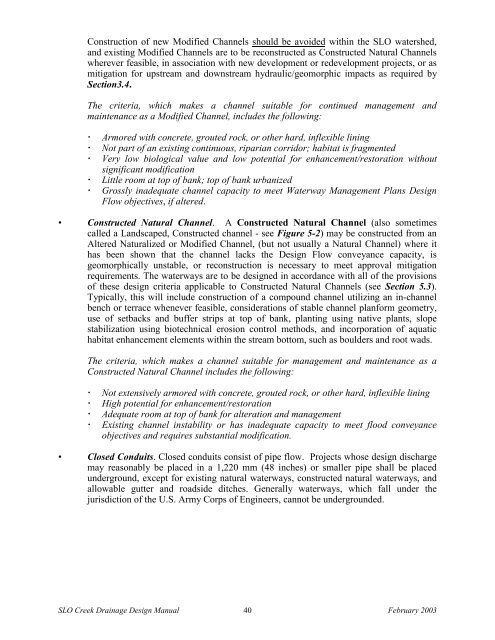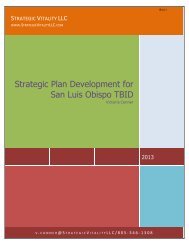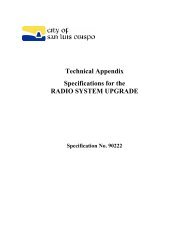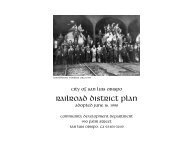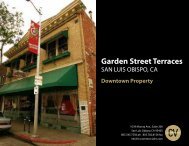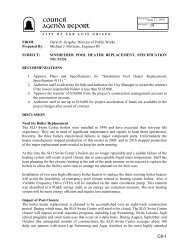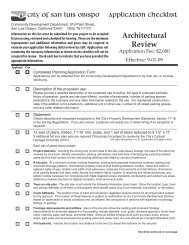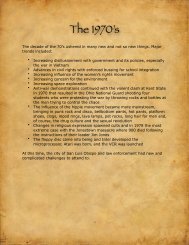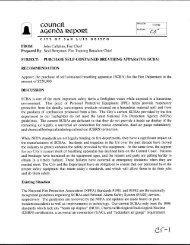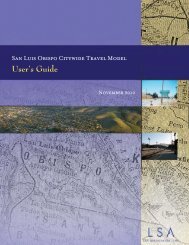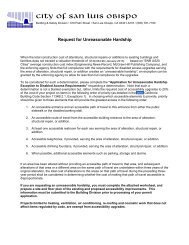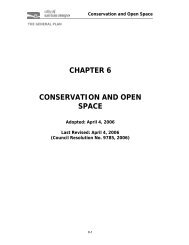Drainage Design Manual - the City of San Luis Obispo
Drainage Design Manual - the City of San Luis Obispo
Drainage Design Manual - the City of San Luis Obispo
You also want an ePaper? Increase the reach of your titles
YUMPU automatically turns print PDFs into web optimized ePapers that Google loves.
Construction <strong>of</strong> new Modified Channels should be avoided within <strong>the</strong> SLO watershed,and existing Modified Channels are to be reconstructed as Constructed Natural Channelswherever feasible, in association with new development or redevelopment projects, or asmitigation for upstream and downstream hydraulic/geomorphic impacts as required bySection3.4.The criteria, which makes a channel suitable for continued management andmaintenance as a Modified Channel, includes <strong>the</strong> following: Armored with concrete, grouted rock, or o<strong>the</strong>r hard, inflexible lining Not part <strong>of</strong> an existing continuous, riparian corridor; habitat is fragmented Very low biological value and low potential for enhancement/restoration withoutsignificant modification Little room at top <strong>of</strong> bank; top <strong>of</strong> bank urbanized Grossly inadequate channel capacity to meet Waterway Management Plans <strong>Design</strong>Flow objectives, if altered.• Constructed Natural Channel. A Constructed Natural Channel (also sometimescalled a Landscaped, Constructed channel - see Figure 5-2) may be constructed from anAltered Naturalized or Modified Channel, (but not usually a Natural Channel) where ithas been shown that <strong>the</strong> channel lacks <strong>the</strong> <strong>Design</strong> Flow conveyance capacity, isgeomorphically unstable, or reconstruction is necessary to meet approval mitigationrequirements. The waterways are to be designed in accordance with all <strong>of</strong> <strong>the</strong> provisions<strong>of</strong> <strong>the</strong>se design criteria applicable to Constructed Natural Channels (see Section 5.3).Typically, this will include construction <strong>of</strong> a compound channel utilizing an in-channelbench or terrace whenever feasible, considerations <strong>of</strong> stable channel planform geometry,use <strong>of</strong> setbacks and buffer strips at top <strong>of</strong> bank, planting using native plants, slopestabilization using biotechnical erosion control methods, and incorporation <strong>of</strong> aquatichabitat enhancement elements within <strong>the</strong> stream bottom, such as boulders and root wads.The criteria, which makes a channel suitable for management and maintenance as aConstructed Natural Channel includes <strong>the</strong> following: Not extensively armored with concrete, grouted rock, or o<strong>the</strong>r hard, inflexible lining High potential for enhancement/restoration Adequate room at top <strong>of</strong> bank for alteration and management Existing channel instability or has inadequate capacity to meet flood conveyanceobjectives and requires substantial modification.• Closed Conduits. Closed conduits consist <strong>of</strong> pipe flow. Projects whose design dischargemay reasonably be placed in a 1,220 mm (48 inches) or smaller pipe shall be placedunderground, except for existing natural waterways, constructed natural waterways, andallowable gutter and roadside ditches. Generally waterways, which fall under <strong>the</strong>jurisdiction <strong>of</strong> <strong>the</strong> U.S. Army Corps <strong>of</strong> Engineers, cannot be undergrounded.SLO Creek <strong>Drainage</strong> <strong>Design</strong> <strong>Manual</strong> 40 February 2003


